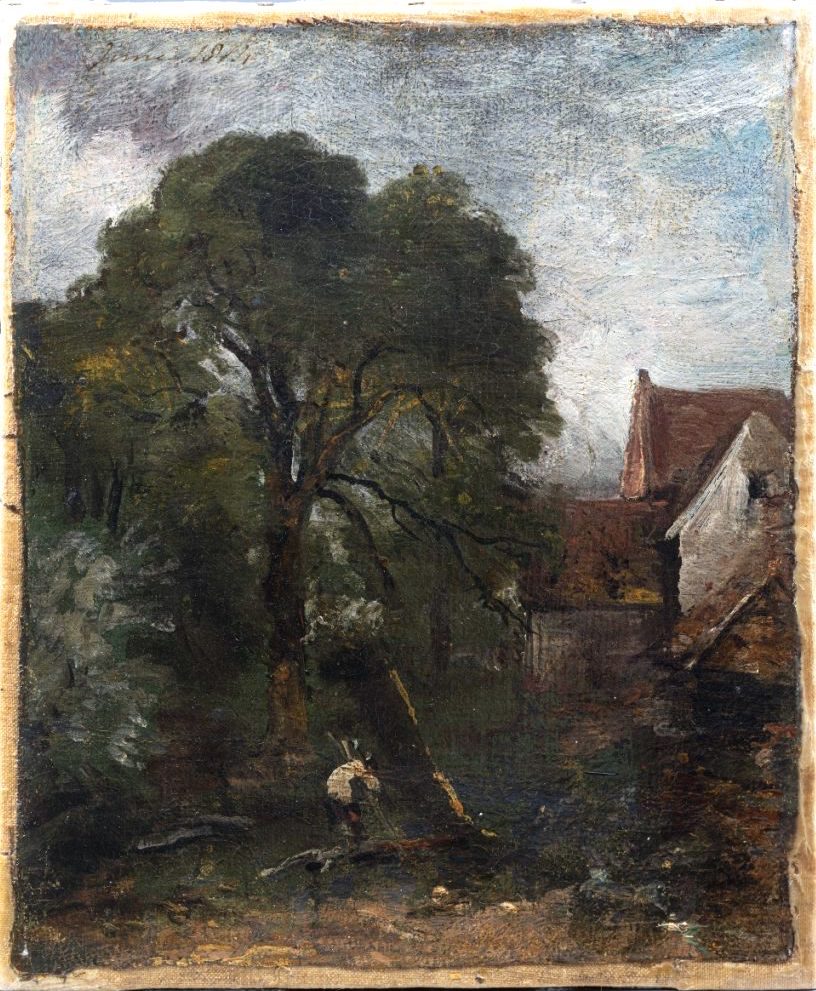An newly attributed oil sketch by the renowned 19th-century English landscape painter John Constable has gone under the hammer in Guernsey. The painting was discovered in a local townhouse and not thought to be of any real value. The artwork achieved an impressive £200,000 ($245,000) at Martel Maides Auctions, a local auction house. This outcome exceeded expectations. The work was initially estimated to sell for between £80,000 and £120,000 ($98,000–$147,000).
Jonathan Voak, a specialist in paintings at Martel Maides Auctions, described the electrifying atmosphere in the saleroom, with multiple telephone bidders and a packed audience keen to witness the sale. The level of interest in the artwork exceeded all expectations.
This diminutive painting is attributed to one of England’s most celebrated landscape artists of the 19th century. It is associated with Constable’s masterpiece, “The Hay Wain” (1821), displayed in London’s National Gallery. It depicts the same endearing cottage, Willy Lott’s pastoral residence in Suffolk, albeit from a different perspective. A figure chopping logs is also depicted, suggesting that Constable created this swift open-air sketch on-site.
The whereabouts of this artwork had been a mystery for nearly half a century. However, experts could identify it based on a record in a rare Italian publication cataloguing Constable’s works in 1979. A label on the back of the frame traces its provenance to Hugh Golding Constable’s grandson, who sold it to the art dealership Leggatt Brothers.
The painting was rediscovered among many items left behind by the deceased owner of an old house in Guernsey, the Channel Islands. The late occupant’s estate was entrusted to Martel Maides Auctions in St. Peter Port. The auction house’s team located the artwork “in a dark corner of the dining room.” Subsequent research has dated the painting to June 1814.
While the winning bidder’s identity has remained undisclosed, Voak shared that they are a resident of the island. He expressed his belief that the people of Guernsey would be pleased to know that this significant piece of art will remain in the local community. In the lead-up to the sale on September 21, many locals visited the auction house to view the artwork, which was displayed publicly.
John Constable (1776-1837) was an influential English landscape painter, renowned for his idyllic depictions of the English countryside during the early 19th century. Born in Suffolk, England, Constable showed an early talent for art and began formal training at the Royal Academy in London in 1799.
Constable’s work is characterised by his keen observation of nature, capturing the changing effects of light and weather with remarkable precision. He often painted scenes from his native Suffolk, focusing on rural landscapes, meadows, and the picturesque countryside. His use of vibrant colors and innovative techniques made his paintings stand out during his time.
One of Constable’s most famous works is “The Hay Wain” (1821), which depicts a tranquil scene along the River Stour. The painting is considered a masterpiece of Romantic landscape art and exemplifies Constable’s ability to evoke a sense of nostalgia and pastoral beauty.
Throughout his career, Constable faced challenges in gaining recognition from the art establishment, but his dedication to capturing the natural world with authenticity eventually earned him acclaim. His influence extended to later artists, particularly the Impressionists, who admired his focus on capturing light and atmosphere in outdoor settings.
John Constable’s legacy endures through his contributions to the development of landscape painting and his impact on subsequent generations of artists. His work continues to be celebrated and studied, and he remains a revered figure in the history of British art.

